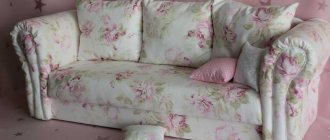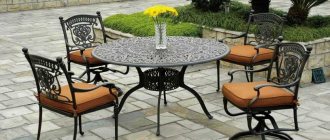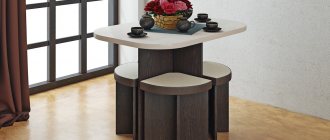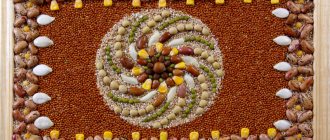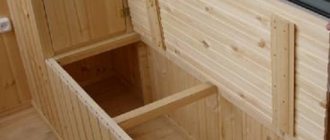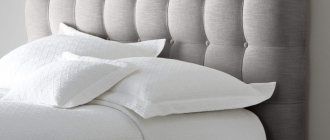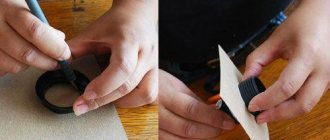How to sew a soft cushion on a chair with your own hands
Even before you start sewing a seat, you need to decide on the color (according to furniture, curtains, wallpaper, etc.), the type of product and how to attach it to the chair. Here everything will depend on the characteristics of the environment and the preferences of the person concerned.
In order to prevent health from deteriorating, we came up with chair cushions that are designed to solve this problem.
Important! When the purpose of a thing is convenience, it is better to choose calm, neutral colors. And if you want to add some zest to the design of the room, you should give preference to bright fabric with an unusual pattern. The color of the sewing threads should be in harmony with the material from which the pillow is sewn.
Since no one wants to encounter such a phenomenon as the seat sliding off the high chair, you should think about a suitable method of securing it:
- ties;
- ribbons;
- Velcro;
- rubber bands.
With the help of textile components, you can transform any room interior beyond recognition.
In addition, suitable materials and tools are prepared in advance. And it’s good if you work on the pattern in advance in accordance with the desired size and shape. But step-by-step instructions will tell you how to sew a pillow on a chair with your own hands, allowing even a beginner to complete the job. In order not to be mistaken, it is worth dwelling on each of these questions separately.
Selection of tools and materials
The seat cushion will serve for a long time and will fit harmoniously into the environment only with the right choice of materials and careful adherence to the instructions for performing the work. The necessary tools will help ease the effort and improve the quality of performance. To sew a seat, you will need the following:
- Sewing machine;
- Awl;
- Scissors (preferably tailor's);
- Threads of different thicknesses and needles of different lengths.
Before starting work, stock up on the necessary tools and materials.
Textile
In addition to color, when choosing fabric for a pad, you should pay attention to wear resistance and guaranteed durability. In this regard, it is worth highlighting rep, teak or satin. And in the case when the chair will be used outdoors, it is best to give preference to felt fabric or use old jeans.
With the choice of suitable material, the strength characteristics will match the nature of use. In addition, an attractive appearance and the most comfortable feeling for a person are achieved. The most important thing is that it is easy to avoid unnecessary expenses. The fact is that for such work they usually take materials and tools that can be found in every home.
If the pillow is intended to be used as a seat, then you need to pay attention to durable, wear-resistant fabrics such as gabardine, rep or teak.
Filler
One cannot but agree that each of us wants to sew a seat on a stool in accordance with our own ideas about comfort. A special role here is played by the characteristics of elasticity and resistance to deformation. The correct choice of filler will help you achieve the desired results. When it comes to bench seats, a variety of materials are used:
- Hollow fiber (good shape retention);
- Sintepon;
- Synthetic fluff;
- Foam rubber (thin furniture version);
- Latex;
- Buckwheat and sunflower husks;
- Small scraps of yarn and non-woven fabric;
- Bulk polystyrene filler, etc.
If the choice falls on synthetic fillers, the most commonly used ones are polyurethane foam, polystyrene, synthetic padding, and holofiber.
Another requirement will be the environmental safety of the material. In addition, you should remember the following points:
- If one of the fillers is unstable, use 2-3 layers;
- For foam rubber and holofiber, the correct pattern is enough.
Pattern
To make a pattern for a chair cushion with your own hands, all you need to do is decide on the size and choose the shape of the product. In accordance with individual preferences, it can be a rectangular object, round or an intricate configuration. And although everything is determined by the size of the chair or stool, the pattern should be a couple of cm larger than the area of the seat for which it is being sewn. The fact is that as a result of stuffing, the dimensions of the product change downwards.
Before cutting, you should ensure that the pattern includes all possible tolerances.
Additional Information! Exact matching to the dimensions of the chair is ensured by using tracing paper, which is applied to the seat and outlined with a marker. And you can cut a pattern with scissors only after the desired shape of the product has been drawn in accordance with careful calculations and measurements.
Sewing a pillow
When it comes to sewing a pad, it is very important to follow the step-by-step instructions:
- Cut out the shape of interest according to the outline of the pattern markings.
- Cutting 2 identical pieces of fabric (with an allowance of 1.5 cm).
- Preparing the filler (according to the pattern).
- Stitching the piping on a sewing machine and attaching it to the fabric (above).
- Place the two pieces of the pillow next to each other, pin them together and sew them together.
There is only a small pocket left to insert through the filler. Next, you should turn the existing allowances, undercuts and corners inside. The already sewn cover needs to be carefully ironed and filled with filler. And the edges of the hole through which holofiber, foam rubber or padding polyester gets into the pillow should be aligned, bent inward and stitched with a hidden seam. At the same stage, all seams of the quilted pillow are stitched.
In some cases, the filler is additionally stitched to avoid the formation of lumps and matting.
Important! Don’t forget to mark in advance the attachment points for the ties that will be sewn on the underside of the workpiece.
In the case of sewing using the patchwork technique, the pattern is prepared using different patches (often different not only in color, but also in shape).
In addition to its useful purpose, the product will also play the role of decorative decoration.
Note! The greater the differences between the parts, the more interesting the product will be.
What will you need for the job?
To sew comfortable seats you will need the following:
- beautiful bright fabric - for the front side of the products;
- dense material - for the reverse side of the seats;
- fabric or wide tape, braid - to create a pipe edging;
- cord-pipeline, you can use any thick cord;
- a thin dense sheet of foam or foam rubber, used as a sealant;
- Velcro suitable for fixing the seat on the upholstery of a chair;
- sharp cutter;
- ruler and marker;
- sewing supplies and machine.
Velcro should be chosen wide and dense, since it is what secures the product to the chair seat.
How to make a knitted round chair cushion
Each of us is free to decide whether a cushion will be sewn for the stool or, to suit our own preferences, we will have to make a knitted version. In the second case, a soft item for interior decoration and increased comfort is knitted from yarn using a hook or knitting needles. To make a round chair cushion with your own hands, follow the circular pattern.
Such products are often made in the form of thin mats for benches, plastic or wooden chairs, or for the back of a chair.
Note! With a preference for knitting, there will be no problem creating colorful seats similar to the patchwork technique. To do this, the product is made by connecting multi-colored rhombuses, squares, etc. together.
It will not be difficult to prepare soft knitted items from pompoms. For their manufacture, the remains of any colored yarn, previously wound on a template or fingers, are suitable. To get a fluffy ball, the base must be tied in one place, cut and fluffed. Well, then the pompoms are tied at the same distance onto a mesh base made of plastic, curtain fabric or crocheted mesh. In addition, knitted pillows can be decorated with tassels in the corners.
Additional Information! Seats for stools turn out to be especially beautiful if they are knitted from fancy yarn, similar in appearance to “fur” or “grass”. Moreover, you choose the knitting density and pattern yourself.
Types of chair accessories
Accessories for chairs and stools have been actively used in interior design for several hundred years. Housewives have always sought not only to decorate the room with handmade products, but also to add comfort. Over time, special linings for furniture began to acquire more functional features. Special devices appeared that fixed the furniture accessory and prevented it from slipping out of place. These could be used:
- ties;
- buttons;
- rubber bands.
Such functional elements became an additional decorative accent.
The seats, which were sewn by housewives, can in turn be divided into the following:
- in patchwork style;
- knitted;
- quilted;
- twisted from ropes and plaits;
- mini rugs made of threads and pompoms.
Knitted round crocheted seats used to be often found in apartments, but even now they have not lost their popularity. Made with your own hands, they give the interior a special soulfulness and warmth. There are chair cushions created using patchwork and tapestry techniques; soft seats are often sewn from scraps of fabric or wool pompoms. Beautiful decor in the form of buttons, bows, ribbons, and ribbons complements the hand-made product.
Decorating a pillow
A ready-made pillow of any type can be easily transformed by decoration. Products decorated with beads, beads, sequins, buttons, etc. are suitable for interior decoration. Well, if your goal is to increase comfort, then the best options would be not too voluminous appliques, ruffles, lace or embroidery.
To avoid problems with the drawing, first make a sketch, transfer it to tracing paper and cut out a stencil. And if braid is used as decoration, it is first pinned with pins, and only then sewn on by hand.
Almost any decorations are suitable for decorative models: bows, embroidery, appliqué and others.
Stage one: creating a template and cutting the material
The seat consists of three layers made of different materials - front and back sides and a sealing insert. It is these parts that need to be cut out of fabric and cut out of foam using a pre-made template.
The police told how to identify scammers and not lose capital
Mom and son blow bubbles in the cold, and the result is amazing: photo
Which countries will compete for Russian tourists in the summer of 2021
The template is very simple to make - a sheet of paper needs to be placed on the seat of a chair, folded and cut along the contour. This pattern will be used for working with fabric. To cut the seal, you will need to make another template, similar in shape, but slightly smaller in size. The difference should be 1.5-2 cm, it should not be made more, since the fabric is cut with added seam allowances.
You need to do the following:
- iron the fabric;
- attach the pattern to the material with tailor's pins;
- trace the pattern along the outline with a tailor's chalk or pencil;
- repeat the outline to indicate the seam allowance;
- cut out the seat part from the fabric.
The seal material is cut slightly differently. The template must be attached to a sheet of foam and traced around its outline with a marker. Then the material is cut with a sharp knife along the marked lines. When cutting, you need to use a board or ruler; this little trick will make the work much easier.
“Electra”, in tune with our time: the premiere of the opera took place in St. Petersburg
Al Capone's 100-year-old "moonshine distillery" found in the USA - photo
How much did Valentine's Day cost Russians: survey results
Once all the details are ready, you need to cut the fabric for sewing the piping. The piping in the presented project is a wide strip of fabric cut on the bias. When sewing, a pipeline is created in the edging into which the cord is inserted. Of course, if you use a wide ribbon or braid, there is no need to cut the fabric for edging.
If you use rolled Velcro tape in your work, it must be cut into rectangles, which will need to be sewn to the seats.
Pillow care
All items that come into contact with people in one way or another need sanitary and hygienic procedures. Seats for benches will be no exception. It is noteworthy that proper care of them prolongs their operation, maintaining an attractive appearance and shape. The appropriate procedures depend entirely on the design features and type of filler.
Bright decorative pillows have a great effect not only on the mood, but also on the entire environment as a whole.
In some cases, washing is allowed (hand or gentle in a washing machine). If light and monochrome products can be placed in water with a temperature of 40 degrees, then the presence of bright and combined shades forces the use of exclusively cold water. Some items can only be dry cleaned by a professional dry cleaner.
The product must be dried in a horizontal position. This is the only way to prevent the filler from clumping. When unfolding the seat, do not allow any folds to form. The item should be turned over from time to time. As for ironing, it is not recommended.
To change the mood and dynamics of the interior of the room, just change the covers on the decorative pillows, and you will get new unforgettable impressions from the comfort and relaxation zone.
If all instructions regarding sewing, operation and care are followed, things will delight us with comfort and aesthetic appeal for a long time. Moreover, making cushions for stools and chairs does not require any special skill. It is also important that working with your own hands increases self-esteem and serves as an excellent opportunity to decorate your own home without additional costs.
Buttons
Choose the number of buttons yourself. It could be one large one in the center or three or four small buttons.
The buttons need to be trimmed: this way they will look more beautiful and become comfortable when using the pillow. Let's look at the simplest way to do this:
- Cut a circle from the fabric whose diameter is 2 times larger than the button.
- Take a thread and a needle and place a circle over the button. Insert the needle from the wrong side of the fabric (you need to step back 1–2 mm from the edge).
- Grab the opposite edge of the fabric from the front side. The button should be inside.
- Do the same with the remaining two sides.
- Now you need to connect the formed corners. Hook them with a needle along the edges on opposite sides and sew.
- The button for the pillow is ready. Sew the rest of the buttons in the same way.
On the pillow, mark with a marker the points where the finished buttons will be sewn. Distribute them so that they are an equal distance from the edge and from each other. Take your thread and needle again and push it through the inside of the button. Next, in the marked place, pierce the pillow right through with a needle. From the reverse side, bring the needle back to the front part and tighten the thread so that the button goes inside and creates a beautiful volume. Then pick up the button and again bring the needle to the back of the pillow, tie a neat knot there. Do the same with the other buttons.
Now is the time to try on the finished pillow. To ensure that the product holds well, hook the elastic band through the two legs of the stool.
This work will not take much time, but you will make the chairs soft, comfortable and beautiful with your own hands.
Model selection
How to make a birdhouse with your own hands: step-by-step master class (photo + video)
Recently, it has become fashionable to sew chair covers with your own hands. This way you can update the interior with the help of capes and other elements. This not only adds originality, but also allows you to change the decor in the apartment without buying new furniture. By making chair covers with your own hands, you can experiment with the style of the room at least every month. Such covers allow you to decorate your home for a holiday or special occasion; they are even used in expensive restaurants and cafes.
In addition to the ease and simplicity of sewing chair covers, this method of changing the interior has several advantages:
- it’s cheaper than buying new furniture or reupholstering it;
- capes protect expensive upholstery from pet claws and hair;
- furniture covers allow it to always remain clean.
The simplest case in shape is one-piece. It will consume more fabric than others, but it has many advantages. First of all, such a cape completely hides the chair. You can choose the height of the skirt to the middle of the legs or to the floor. This will hide the imperfections of the furniture. To make a pattern, you need to measure the height of the backrest, the chair itself, the width and depth of the seat.
DIY chair covers can come in several varieties:
- Universal – secured at the back with ties or clasps. They can hide the entire chair, while sitting on it freely. There may be a cape on the back and seat in the form of one piece of fabric, which is secured on the side with ties.
- A half-cover is a product that does not completely cover the furniture. Usually it is fixed to the legs or corners of the chair using braid or elastic.
- One-piece or separate covers. Seat-only covers are popular. They are the easiest to sew and require little fabric.
- Beautiful luxury cases. They are often used in cafes during banquets. You can sew such a chair cover with your own hands for a home party. It will require expensive fabric and various decorative elements.
Universal
Half-case
Separated
Luxury case
How to remove the seat?
Usually, when you turn a chair upside down, you can immediately see where it is attached with screws or bolts to the wooden structure. Using a screwdriver or screwdriver, carefully remove the fasteners and release the seat.
Then you can, without sparing the old fabric, remove the old upholstery. Usually it is attached to construction clips, so that they can be easily removed using a knife or a regular screwdriver. Throw the torn fabric, along with old foam rubber, into the trash without regret. And we transfer the wooden or, most likely, plywood base to the work table for further processing.
Crazy patchwork seat
A soft seat cushion made using the patchwork technique is not only a good way to make a chair comfortable, but also to recycle various remnants of fabric that have accumulated in the house.
Algorithm of actions:
- We are preparing materials: bright scraps of fabric, filling (holofiber or padding polyester is a good option), braid. A sewing machine will speed up the process of assembling the pillow.
- Let's make a pattern. To do this, using the measurements of the chair seat, we draw a paper model of the future seat. Using a paper pattern, scraps of fabric are laid out in random order (checkerboard, in a circle, in sections). Additionally, the back side of the pillow is cut out from a single piece of fabric.
- Sew the pillow. According to a pre-made layout, the fabric flaps are sewn together. Folded right side inward, the patchwork fabric and the whole side of the pillow are stitched together.
Important: when assembling, leave one corner of the pillow unsewn.
- Filling the pillow. Through a hole in the corner, the seat is filled with padding polyester or holofiber.
- The final stage. The hole is carefully sewn by hand. Braid ties are sewn at the corners.
Related article: How to turn a closet into a cozy dressing room [6 fresh ideas]
Selection of materials
Textiles for chair cushions should be selected taking into account maximum resistance to humidity, low or high temperatures, and direct sunlight. These factors are important, because seats can be used not only for home furniture, but also for garden furniture.
Textile
It is worth noting that not all materials are suitable for making a chair cushion with your own hands. The fabric for the future seat should be pleasant to the touch, wear-resistant and, most importantly, pleasing to the eye. Among the most popular options for sewing a cover for a stool with your own hands, there are several types:
- Linen. It can be used for a long time without changing its appearance. This material is relevant for kitchens made in Provence or country styles. Disadvantages: rough texture and difficult to iron.
- Cotton. This material is durable, hypoallergenic and inexpensive. Washable. The disadvantages include rapid wetness. Paints applied to fabric fade quickly in direct sunlight.
- Lycra. This material is elastic and stretches well in all directions. It is also highly resistant to external factors and washes well.
- Gabardine. This type of fabric can be called one of the most successful for sewing chair cushions with your own hands. It has an attractive appearance, is easy to clean, and dense.
Linen
Cotton
Lycra
Gabardine
There are various ways to decorate pillows that you can do yourself:
- Braid. Gives a finished look and looks impressive. To secure the braid, the edging is placed in the middle of the main seam line and basted.
- Cord. This decor fits perfectly into the classical, baroque, and empire style. Additionally, the product can be decorated with tassels. Best combined with velor, velvet, silk.
- Frill. To make the products look softer, you can buy a ready-made frill or make it yourself. In this case, select a contrasting color or to match the base material.
- Fringe. A short frame will make the seat beautiful and neat, while a long frame will not suit every interior.
Any decor is selected taking into account the characteristics of the furniture’s use.
Braid
Cord
Frill
Fringe
Filler
Before sewing chair cushions, you need to choose a filling for them. With all the diversity, each of them has its own advantages and disadvantages. A distinction is made between natural and synthetic materials.
The most popular natural fillers:
- Feather and down are light raw materials, which require a large amount to make a soft seat.
- Sawdust – cedar and pine shavings are usually used. These fillers have a healing effect, for example, the aroma of pine needles helps with headaches. But sawdust wrinkles over time and needs to be changed periodically.
- Buckwheat - seats filled with this filler are very popular, as the seat turns out to be very convenient and comfortable.
- Sheep wool is soft, practical, pleasant to the touch.
- Horsehair has all the benefits of wool, but the seat is tough.
There is one advantage of natural materials - there are no toxic chemical additives. Disadvantages include short service life, possible allergic reactions, and are not suitable for outdoor furniture.
Feather, fluff
Sawdust
Buckwheat
Sheep's wool
Horsehair
Synthetic materials include:
- Expanded polystyrene is a filler that consists of small granules. Foamed, hard and light balls add volume to the pillow. This material has an orthopedic effect. Over time it becomes wrinkled and requires replacement.
- Polyurethane foam is a rigid filler that does not cause allergic reactions. The material can retain its shape for a long time.
- Polypropylene - elastic plastic balls recover almost immediately after sitting on the cushion. When ignited, the composition releases toxic substances.
- Foam rubber pillows are soft, lightweight, and have a long service life. The most commonly used brands are EL 2540, EL 2842, the thickness of the material is chosen within the range of 5-10 cm.
- Holofiber is light in weight and can be used in combination with other synthetic fillers. Does not cause allergic reactions, is resistant to moisture, does not absorb foreign odors.
- Sintepon - placed on top of the foam rubber, does not allow the facing material to stick or stretch, and evenly distributes the load. It is recommended to choose padding polyester with a density of 100 g/cm2.
All synthetic fillers quickly restore their original shape and do not cause allergies. Can be used for garden furniture.
Expanded polystyrene
Polyurethane foam
Polypropylene
Foam rubber
Holofiber
Sintepon
Making a pattern
To ensure that there is no excess material left after sewing, because beautiful upholstery fabric is not cheap, you need to take the necessary measurements from the dismantled seat in advance. First you need to measure the length and width of the plywood part. Then add the height of the plywood and foam sheet, as well as a few centimeters on the fold of the fabric.
The foam rubber is cut to the exact size of the seat, and more fabric will be used for the cover itself. For sewing chair seats with your own hands, a photo of the pattern is given in the article. But this scheme is suitable for the classic version of furniture with a square seat.
